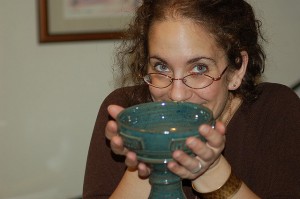Yesterday, I invited people to identify objects that they find telling.
I got some great answers. (Please, it’s not to late to submit. Send me entries as comments to grant27 AT gmail DOT com, or leave them as comments below.)
From Richard Shear:
I would submit two things, one I own and one I admire. The former is my Macintosh 128 purchased from a Manhattan Apple dealer on the Monday morning after the now iconic 1984 Super Bowl ad.
The latter is any plate from Josiah Wedgwood’s 944 piece "Frog" service produced for Catherine the Great, and introduced with great fanfare in a custom designed London showroom in 1773.
These are both products of unique businessmen and entrepreneurs with a keen sense of design, technology, retail merchandising, marketing, showmanship, the power of brands, and, yes, contemporary culture.
They may have been introduced 211 years apart, yet they both created the same kind of buzz, with people waiting in line anxiously anticipating the chance to see and admire. The legacy of Wedgwood has endured. It would be interesting to see where Steve Job’s legacy stands in the year 2195, 211 years after the introduction of MacIntosh 1984.
From Carol Saller:
The diary my father kept as a teen during WWII. His older brother was a bomber pilot, but Dad stayed on the farm.
Students love the war passages, the girl-crush passages, the mischief, and just generally the look into such a foreign time and place. (There are passages that make almost no sense to modern urban kids.)
The diary has launched conversations about the war, farm life, writing a diary or journal, 1940s culture, and how language changes and stays the same.
For Carol’s blog, go here.
For more on Carol’s father’s war diary,
go here.
From Grant McCracken:
This is one of the few personal things to survive from my childhood. Happily, it’s one of the most telling. It’s a toy soldier, a Scottish Highlander. It’s made from some kind of rubber. The left arm, the one bearing the rifle, actually swivels, something I found thrilling as a kid. On the bottom, it reads "Made in England."
This soldier comes from a Canada long since passed. This was the (part of) Canada that admired things British, the Canada that was still very much a part of a commonwealth, the Canada not long removed from it’s status as a colony.
How did these Canadians raise their kids? With toys that celebrated their Scottish connection as this was played out in the service of empire. It sounds a little sad, I know. But it was an excellent childhood. Any kind of service is good training. You can change the object of the service as you go.
From Steve Crandall
I have indirectly done this [the Prown teaching technique] when I teach and bring in a slide rule.
I worry about the high level of innumeracy among students and a slide rule represents an elegant way to immerse yourself in ‘back of the envelope’ calculations.
It gives a sense of what a logarithm is and you have to sort out the powers of ten and carry them in your head. It is also only approximate and I believe that gives a natural feeling towards understanding and analyzing errors and error propagation.
Of course these are archaic in general use, but it is a way to be playful with simple calculations and perhaps understand more deeply than students who blindly plug numbers into spreadsheets and the like.
From Carlen Lea Lesser:
I think it’s telling that I’m having a hard time choosing just one or two things. I was going to pick the toy stuffed rabbit I’ve had since I was a baby, but I realized I don’t have any pictures of it!
Then I racked my brain a bit and settled on my "Prophets’ Cup." I had this custom made for me a few years ago for Passover.
Traditionally there is an Elijah’s cup at Passover and some have also added a Miriam’s cup. I actually wrote my own haggadah for Passover (even sold a few copies), and evolved this concept into a "Prophets’ Cup."
To me this cup represents a lot, since it’s a product of my research, scholarship, imagination, creativity, writing, experimentation and eventual collaboration with a potter to create it. I feel like this cup presents so many opportunities to have conversations and ask questions that I guess it would be the one I would use.





There are so many things that spring to mind – historically I’d probably put down one of the early competitor paperclip designs, that was beaten out by the classic shape. There’s so much of our culture in the paperclip – industrial design, our paper culture in organisation and industry. And the reminder that our current shapes were not the only option. In this case “function” and “simplicity” seem to have triumphed, but it’s not always so.
For a less historical example, I’d like to suggest the Vuvuzela. The lowest of low tech and apparently the lowest of low brow culture… and yet… some people can carry a basic tune… and most critically it’s a very low tech way for poor masses to amplify their voice to compete with the technology and power of a media conglomerate… at least for a little while. We’ve had colour revolutions and flash mobs… but I can see some future state where there’s a vuvuzela revolution, protestors called together and amplified by this plastic horn…